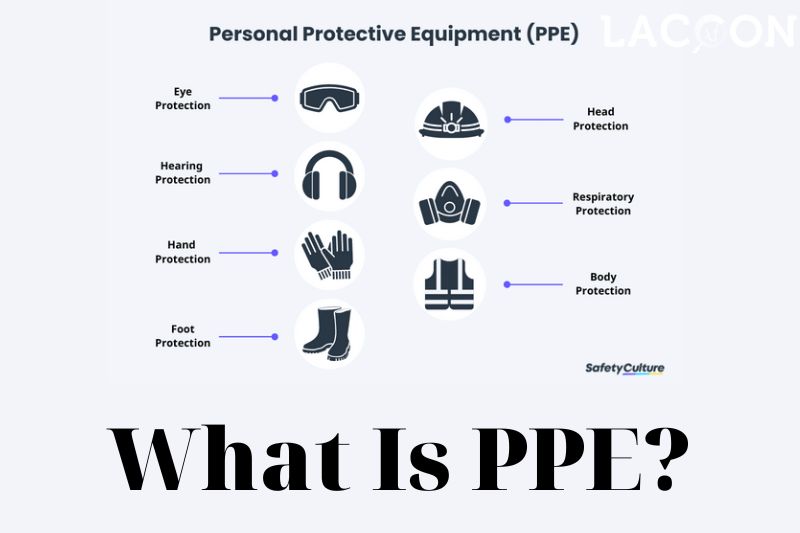Personal Protective Equipment, commonly known as PPE, is a crucial component of workplace safety. PPE was designed to protect workers from occupational hazards that can cause harm to their health and safety.
These hazards can include physical, chemical, biological, and radiological factors that can be present in various industries and workplaces. PPE is used to create a barrier between the worker and these hazards, providing an additional layer of protection.
Lacoon will explore what is PPE and the different types of PPE available to workers in this blog. Moreover, we will discuss the proper use and maintenance of PPE to ensure its effectiveness in protecting workers from harm.
What is PPE (Personal Protective Equipment)?

Personal Protective Equipment (PPE) refers to specialized clothing and accessories designed to protect workers from workplace hazards such as physical, chemical, electrical, radiological, and biological dangers.
PPE serves as the last line of defense when engineering controls, administrative controls, and safe work practices are insufficient to mitigate risks.
Why is Personal Protective Equipment (PPE) Important?

PPE is crucial for various reasons, spanning across diverse industries and occupations. Its importance can be highlighted through the following points:
- Protection against hazards: PPE is like a superhero costume for workers. It helps protect them from many dangerous things like chemicals, germs, and radiation. It helps prevent injuries, illnesses, and fatalities from exposure to such hazards.
- Compliance with regulations: Companies must follow rules to ensure workers are safe. One of these rules says that they must give workers PPE when needed. These rules were made by the Occupational Safety and Health Administration (OSHA) to help keep workers safe.
- Improved worker morale and productivity: When companies give workers PPE, it makes them feel like the company cares about them. This can make workers happier and do their job better. When workers feel safe, they work harder and better. A safe work environment means less chance of someone getting hurt or sick, which can help workers be more productive.
- Cost-effective: Buying PPE might seem expensive, but it can actually save a lot of money. If someone gets hurt at work, the company has to pay for things like medical bills and lost work time. PPE can help stop these accidents from happening. So, it’s like investing in safety now to avoid bigger costs later
- Reduction in workplace incidents: When everyone at work wears PPE, there are fewer accidents. This makes work go smoother and faster, which is good for everyone. When accidents don’t happen, work can keep going without stopping, which means getting more work done in less time.
- Protection against infectious diseases: During the COVID-19 pandemic, PPE like masks, gloves, and gowns has been really important for healthcare workers. It helps keep them safe from getting sick while they help other people. PPE can help stop the spread of germs by keeping them away from workers’ bodies.
What Can Be Done To Ensure The Proper Use Of Personal Protective Equipment?
Proper use of PPE involves various steps, including risk assessment, selecting the right equipment, employee training, testing, and inspection.
Employers must ensure that workers use PPE correctly and consistently to maximize protection.
The 4 Basic Types of PPE and Their Examples:

1. Face and Eye Protection:
Face and eye protection are like special equipment that workers can wear to keep their face and eyes safe. It includes things like safety glasses, goggles, face shields, and welding helmets.
They help protect workers from things like flying debris, chemicals, radiation, and bright light that can hurt their eyes and face.
These devices are commonly used in construction, manufacturing, and laboratory settings.
Safety Tips:
- Choose the appropriate type of protection based on the specific hazards present.
- Ensure a proper fit to avoid gaps and discomfort.
- Replace damaged or worn-out equipment immediately.
- Clean and disinfect face and eye protection regularly.
2. Respiratory Protection:
Respiratory protection is like a special mask that workers can wear to keep their lungs safe. It helps protect them from breathing in bad things like dust, fumes, gases, and vapors.
People who work in places where these things are common, like construction sites, factories, or hospitals, need to use these masks to stay safe.
Safety Tips:
- Conduct a risk assessment to determine the appropriate type of respiratory protection.
- Ensure a proper fit and seal to prevent leakage.
- Train employees on the proper use, maintenance, and storage of respirators.
- Replace filters and cartridges according to the manufacturer’s guidelines.
3. Skin and Body Protection:
Head Protection:
Head protection includes hard hats, bump caps, and helmets, which shield the head from impact, falling objects, and electrical hazards.
They are commonly used in the construction, mining, and manufacturing industries.
Safety Tips:
- Select head protection based on the specific hazards present.
- Ensure a secure and comfortable fit.
- Replace damaged or deteriorated equipment immediately.
- Inspect head protection regularly for signs of wear and tear.
Body Protection:
Body protection is like special clothes that workers can wear to keep their bodies safe. It includes things like coveralls, aprons, and chemical-resistant suits.
They help protect the worker’s torso from things like heat, chemicals, and scratches. These are widely used in construction, chemical processing, and healthcare industries.
Safety Tips:
- Choose body protection based on the specific hazards present.
- Ensure a proper fit to allow for ease of movement.
- Train employees on the proper use, maintenance, and storage of body protection.
- Inspect and replace equipment as needed.
Hands Protection:
Hand protection includes gloves made from various materials designed to protect against cuts, abrasions, chemicals, and heat.
Examples include leather gloves, cut-resistant gloves, and disposable gloves. They are used across various industries, including healthcare, food services, and construction.
Safety Tips:
- Choose the appropriate type of gloves based on the specific hazards present.
- Ensure a proper fit to maximize dexterity and comfort.
- Replace damaged or worn-out gloves immediately.
- Wash and disinfect reusable gloves regularly.
Foot Protection:
Foot protection includes safety shoes and boots designed to protect the feet from impact, punctures, slips, and chemical exposure.
Examples include steel-toe boots, slip-resistant shoes, and chemical-resistant boots. They are often used in building, manufacturing, and food processing, among other fields.
Safety Tips:
- Choose appropriate footwear based on the specific hazards present.
- Ensure a proper fit for maximum comfort and support.
- Replace damaged or worn-out footwear as needed.
- Keep footwear clean and well-maintained.
4. Fall Protection:
Fall protection is like special equipment that workers use to stay safe when they work up high. It includes things like harnesses, lanyards, and anchor points.
If someone works up high in a job like construction, roofing, or window cleaning, they need special equipment to stay safe. This equipment helps them not get hurt if they fall.
Safety Tips:
- Conduct a risk assessment to determine the appropriate type of fall protection.
- Train employees on the proper use, maintenance, and storage of fall protection equipment.
- Inspect equipment regularly for signs of wear, damage, or degradation.
- Replace damaged or worn-out equipment immediately.
Hearing Protection:
Hearing protection is like special devices that workers can use to keep their ears safe. They include things like earplugs and earmuffs.
People who work in really loud places, like construction sites, factories, or airports, need to use these devices to protect their hearing. Loud noises can hurt their ears, and these devices help keep them safe.
Safety Tips:
- Conduct a noise assessment to determine the appropriate type of hearing protection.
- Train employees on the proper use, maintenance, and storage of hearing protection devices.
- Ensure a proper fit to maximize noise reduction.
- Replace damaged or worn-out equipment as needed.
What Does PPE Not Include?

PPE does not include items such as everyday clothing, uniforms, or accessories that do not serve a protective purpose. PPE is really important for keeping workers safe, but it’s not the only way to stay safe.
Other things like making changes to the machines or how the work is done can help prevent accidents.
These are called engineering controls, administrative controls, or safe work practices.
They try to stop accidents from happening in the first place rather than just protecting workers when they happen.
How to Assess and Select PPE

- Conduct a hazard assessment: Identify the types of hazards present in the workplace, such as physical, chemical, or biological dangers.
- Determine the appropriate PPE: Based on the hazard assessment, select the suitable PPE that provides adequate protection without impeding the worker’s ability to perform tasks
- Consult with employees: Involve workers in the selection process to ensure that PPE meets their needs and preferences.
- Consider compatibility: Ensure that different PPE types can be worn together without causing discomfort or reducing protection.
- Choose reputable suppliers: Select PPE from reputable manufacturers that meet regulatory standards.
Training Employees
Employers must provide workers with comprehensive training on the proper use, maintenance, and storage of PPE. This includes:
- When and why PPE is necessary.
- How to wear, adjust, and remove PPE correctly.
- Limitations of PPE.
- Proper care, maintenance, and storage of PPE.
- How to recognize and report PPE-related issues.
Testing and Inspecting PPE
Regular testing and inspection are crucial for ensuring the effectiveness and reliability of PPE.
Employers should establish a schedule for inspecting, maintaining, and replacing PPE based on manufacturers’ guidelines and specific workplace conditions.
Employees should also be encouraged to report any issues or concerns regarding PPE.
COVID-19 Prevention and Control

The COVID-19 pandemic has shown how important PPE is for keeping workers safe, especially in hospitals and clinics.
PPE like masks, face shields, gloves, and gowns have been really important in stopping the virus from spreading and keeping healthcare workers safe.
Companies need to keep using PPE the right way and doing other things to stop the virus from spreading, so everyone can stay safe at work.
Conclusion
Personal Protective Equipment (PPE) is really important for keeping workers safe in different kinds of jobs. It means special clothes or equipment that workers wear to help protect them from getting hurt or sick at work.
PPE can help stop accidents from happening and make work safer. It’s really important for both workers and companies to know how to use PPE properly.
Many kinds of PPE are available, like gloves, masks, safety glasses, helmets, and special suits. Using PPE correctly is a big part of ensuring everyone is safe at work.





